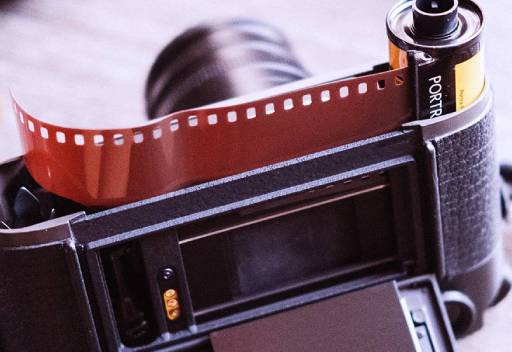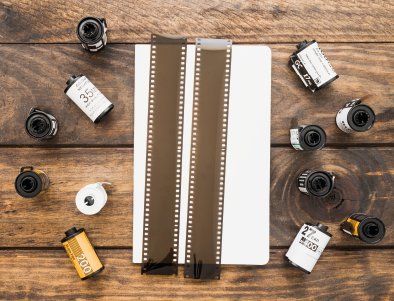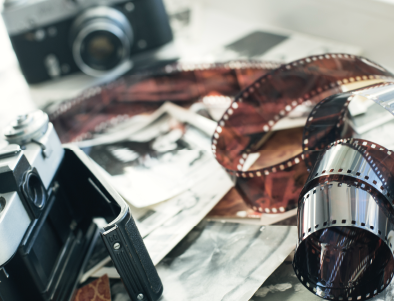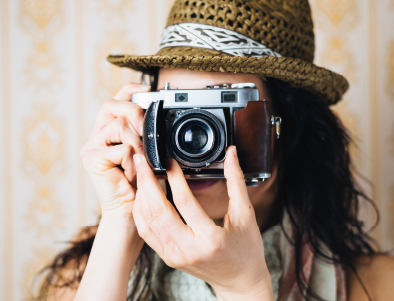
Getting started in film photography? Learn everything you need to know.
It’s official. Film photography is BACK… and it’s not going anywhere.
All over the world, budding photographers are ditching their phones and using film cameras to capture amazing photos instead. However, there are many out there that either don’t see the appeal of film photography or aren’t sure how to get started.
Never fear, our beginner’s guide covers everything from the film photography tips to why you should consider using a 35mm film camera. You’ll feel like an expert in no time.
1. What is film photography?


Let’s start with the absolute basics. Film photography is the art of taking photos on rolls of transparent film, which is coated on one side with a gelatin emulsion containing light-sensitive silver halide crystals.
Also referred to as analog photography, this process involves taking photos with a film-loaded camera, and then developing your film in a darkroom to be processed and printed. It’s all about patience, determination, and getting up close and personal with your treasured snaps.
2. Why use film cameras - benefits of film photography


Since you take so many photos on your phone, you might be wondering about the benefits of using film cameras instead. Digital photography is fast, easy and super convenient, but there are still many advantages to film photography in 2023:
- Film photography gives you total control over shutter speed and image exposure, so your photos will feel more authentic and unique.
- Film can capture subtle details that are lost with digital photography (particularly outdoors), and capture photos at a higher resolution than most digital cameras.
- Due to the more physical nature of the process, film cameras help you learn the basics of photography much faster.
- The process of loading, shooting and then developing camera film feels far more rewarding than shooting digital.
- Film cameras can only take a limited number of shots, so photographers are forced to think more carefully when shooting (ultimately making them better at their art)
- Film photography lets you experiment with authentic artistic effects, such as overexposures and vignettes - without using any editing software.
- The cost of a great film camera is typically much cheaper than the cost of a comparable digital camera.
3. How do film cameras work?


Film cameras are loaded with a roll of light-sensitive film . When the shutter opens, light enters the front of the camera through the lens and prints the image onto the surface of the film. The camera film is then rolled forward, so that an unexposed section of film is ready for your next photo.
A “double exposure” is when a photographer rolls the film backwards instead, layering images on top of each other to produce a ghost-like effect on the photo.
4. What is 35mm camera film


There are just three main types of camera film beginners need to know about. These are standard 35mm film, 120 and 220 medium format films, and older large format films..
Due to its smaller frame size of 24x36mm, standard 35mm film offers a lower resolution and grainier images than the other larger formats. However, it’s often these vintage qualities that make film photography so popular, while 35mm film cameras are cheaper, more portable and significantly easier for beginners to use.
Since it’s so easy to get started, 35mm camera film is still the most popular format used today. It’s available in either 24 or 36 exposure rolls, with a wide range of emulsions.
5. What are the best 35mm film cameras for beginners


When you’re diving into film photography for the first time, choosing the perfect 35mm camera is never easy. There are so many styles, models and features to consider, you might feel completely unsure of where to start (and you’re certainly not the only one).
Although we aren’t here to recommend specific camera models, we recommend that you don’t just choose a camera you like the look of, but also put plenty of research into the functions, features and settings to make sure it’s suitable for what and where you’re shooting.
Alongside quick and easy disposable cameras, there’s a enormous range of fantastic SLR cameras that shoot exclusively 35mm film. In fact, they’re the easiest type of film camera to find, and big camera companies such as Kodak, Nikon, Fujifilm and Canon are always a good place to start!
6. How to put film in a camera


Loading film into most 35mm cameras can be a little tricky. However, just follow these simple steps and you’ll be ready to start shooting in no time at all.
-
Open the back of the camera by gently sliding, then pulling, the rewind knob
-
Unpackage your roll of film and click into position on the cradle, then pull the rewind knob again to secure into place
-
Pull the film lead (the inch of film poking out) across to the right-side of the camera without marking it with grubby fingerprints
-
Lock the film into the winding mechanism by inserting into one of the slots on the spindle
-
Line up the film’s sprocket holes on the sprockets underneath
-
Hold the film firmly in place and spin the film advancement mechanism on the top right of your camera
-
Repeat the above step a couple more times to ensure the film is firmly connected to the spindle
-
Close the camera back up and start snapping!
7. Using your 35mm film camera


Mastering your camera settings is the key to great film photography. Known as the “exposure triangle”, all 35mm cameras have three main settings you should focus on, as these will all help improve the quality of photos taken in certain conditions and situations - such as the light available when you’re shooting.
Shutter speed
Shutter speed is how long the shutter remains open and exposes the camera sensor to light. In the simplest terms possible, this is how long your camera spends taking a photo, which has a huge impact when photographic moving subjects.
Slow shutter speeds are typically used for capturing motion blur, while fast shutter speeds are used to freeze motion instead. Shutter speeds are expressed a measurement of time in seconds, so start shooting at 1/4000 and then slow things down to see the effects!
Aperture
Aperture is simply the size of the opening that lets light into the camera. By choosing experimenting with the f-stops, you can change the aperture size to control the depth of field and exposure of your images.
ISO
ISO is your film’s sensitivity to light and is ultimately a setting that brightens or darkens an image.
Lower ISO numbers (100 or 200) take smooth, high contrast images in lighter conditions, while higher ISO numbers (1600+) deliver brighter, grainer images in darker conditions.
8. 35mm film photography tips for beginners


Getting started with 35mm film photography might feel a little daunting, so here are a few top tips on using your film camera to get the best possible images:
- Experiment with the exposure triangle to find out how these settings work together to remarkable effect
- Keep a record of the photos and the camera settings used for each one, to find out what will work well next time!
- Trial and error has always been a big part of 35mm film photography, so don’t be disheartened if your latest photos aren’t what you expected
- Plan ahead for your photoshoot - pack some extra rolls of film, take note of the weather conditions, and take a journal to keep your records
- Take your time over each photo to make the most of your limited number of shots. Film photography is a marathon, not a sprint
- Try black and white photography to truly master your use of light and shadow, as well as capturing different textures, contrasts and shapes
9. Where to get film cameras developed


Once you’ve filled your roll of camera film, you’ll need to get your images developed in total darkness. Since this is such a complex, specialised process, we recommend all beginner photographers get their camera film developed professionally - rather than attempting to create your own dark room.
There are Snappy Snaps stores all over the UK that can masterfully process your precious camera film, bringing your images to life with the care and attention they deserve. We’ve been developing camera film for over 30 years now, and you only need to speak to other photographers to find out how good we are!
Simply find your local store, bring in your camera film, and our specialists will process them into vibrant, beautiful photo prints in just 1 hour.
